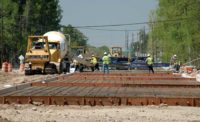Notions of Sustainability Should Include the Word's Full Meaning
The concept of sustainable engineering has been around for more than 25 years. During my term, from 1988 to 1992, as chief of engineers and commander of the U.S. Army Corps of Engineers, I focused on this concept as integral to the Corps' post-Cold War role. Back then and continuing today, this (to me) unassailable concept has been often condemned as a no-growth environmental conspiracy. In the early years, people told me that sustainability was a slogan destined for oblivion.
As Brig. Gen. Anthony C. McAuliffe memorably said 70 years ago during WWII, "Nuts!" Sustainability is a well-established principle that guides much of development today.
 |
| HATCH |
One clear example of this expanded view is New York City's successful effort to maintain its drinking-water and wastewater services from the Catskill-Delaware reservoirs. Historically, this gravity-fed system relied on the purity of its source water, disinfected with chlorine, to provide high-quality water without filtration.
The Safe Drinking Water Act of 1974, however, required public drinking-water supplies drawn from reservoirs to be micro- filtered, unless the source waters could be protected. To avoid building filtration plants, New York City committed, in 1997, $1 billion over a decade to remediate pollution and promote sustainable economic growth in the 1,800-sq-mile Catskill-Delaware watershed.
It was a great success. By not constructing filtration plants, the taxpayers saved from $3 billion to $5 billion. The city instituted a demand management program that reduced, from 1990 to 2009, daily consumption by about 500 million gallons. And the city worked effectively with state and rural governments, environmental groups and other stakeholders to ensure community support.
Bolivian Footbridge
A second example of the full meaning of sustainability is the 2013 winner of the American Society of Civil Engineers' Innovation in Sustainable Civil Engineering Award: a cable-supported footbridge, built with the assistance of the non-profit Bridges to Prosperity, in a remote area of Bolivia. The 520-ft-long bridge over the Rio Mizque has vastly improved safety and enhanced the regional economy. Residents no longer need to walk miles out of their way each day to cross a dangerous, frequently flooded river.
Designed to reduce the excavation and concrete required, the bridge was constructed with local materials and labor under a contract that made the community the owner. The bridge improves access to education, medical care and participation in social and government activities. Further, it has prepared the community to replicate and maintain comparable projects.
The sustainable development process makes new demands on engineers and requires us to change our approach to problem-solving. Traditionally, engineers have been taught to break down a problem into its simplest parts, study the components and devise a solution in a linear manner. Today's challenges, on the other hand, require us to reorient our thinking to a multidimensional, circular process. In order to do that, engineers also must employ the knowledge and skills of physical and social scientists.
Because the pursuit of a sustainable world depends largely on technology and the use and re-use of materials, engineers must reach beyond the stated problem and expected solution to present sustainable alternatives. Those we serve may be open to a better solution, but we must first offer it.
Engineers translate needs, technology and dreams into enduring reality. But we can accomplish this only by engaging all the different decision processes. We must help set the new direction, not just follow.
A former commanding general and chief of engineers of the U.S. Army Corps of Engineers, Lt. Gen. Hatch is a senior adviser at Dawson & Associates, a consulting firm in Washington, D.C. He can be reached at HHatch@dawsonassociates.com.




